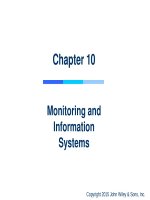Lecture Communication skill: Chapter 10 - Tracey Bretag, Joanna Crossman, Sarbari Bordia
Bạn đang xem bản rút gọn của tài liệu. Xem và tải ngay bản đầy đủ của tài liệu tại đây (285.8 KB, 54 trang )
Chapter 10
Employment
communication
Copyright 2009 McGraw-Hill Australia Pty Ltd
PPTs t/a Communication Skills, by Bretag, Crossman and Bordia
1
10-1
Learning objectives
On completion of this chapter students will
know how to:
• prepare a résumé
• write a cover letter
• prepare for an interview.
Copyright 2009 McGraw-Hill Australia Pty Ltd
PPTs t/a Communication Skills, by Bretag, Crossman and Bordia
2
10-2
Personal résumé
The personal résumé is also referred to as:
• a curriculum vitae (CV)
• a personal profile
• a personal information sheet
• a personal inventory
• biodata.
Copyright 2009 McGraw-Hill Australia Pty Ltd
PPTs t/a Communication Skills, by Bretag, Crossman and Bordia
3
10-3
Personal résumé (cont.)
• Bishop-Firth (2004, p. 39) recommends
keeping your résumé to two pages,
highlighting only relevant information.
• The aim of a résumé is not to document
your life story but to get an interview.
• Employers often only skim read résumés
when making their initial selections so
ensure that the layout and headings make
the document easy to read quickly and to
find the relevant information.
Copyright 2009 McGraw-Hill Australia Pty Ltd
PPTs t/a Communication Skills, by Bretag, Crossman and Bordia
4
10-4
Personal résumé (cont.)
There are five main headings to a résumé:
• Heading
• Education
• Work experience
• Extracurricular activities
• Referees
Copyright 2009 McGraw-Hill Australia Pty Ltd
PPTs t/a Communication Skills, by Bretag, Crossman and Bordia
5
10-5
Heading
The heading includes:
• your name
• home address
• telephone numbers
• email address.
Copyright 2009 McGraw-Hill Australia Pty Ltd
PPTs t/a Communication Skills, by Bretag, Crossman and Bordia
6
10-6
Heading (cont.)
• In the past, date of birth, marital and health
status were included in a résumé but in
many countries, including Australia, it is now
illegal for the employer to ask for this
information and it is therefore not needed.
• You do not need to write the words ‘Name’,
‘Address’ or even ‘Résumé’ in the heading
because the information tells the reader
what it is.
Copyright 2009 McGraw-Hill Australia Pty Ltd
PPTs t/a Communication Skills, by Bretag, Crossman and Bordia
7
10-7
Activity 1
• Complete Activity 1 on pp. 212–213 of your
textbook.
Copyright 2009 McGraw-Hill Australia Pty Ltd
PPTs t/a Communication Skills, by Bretag, Crossman and Bordia
8
10-8
Education
• Deciding whether to place ‘Education’ or
‘Work Experience’ first in the résumé
depends on what you wish to highlight.
• Do not include information about your
primary school education.
• Include a brief account of secondary and
tertiary university education, including dates,
place of study and final qualifications.
• You may wish to mention briefly any
outstanding achievements or leadership
positions.
Copyright 2009 McGraw-Hill Australia Pty Ltd
PPTs t/a Communication Skills, by Bretag, Crossman and Bordia
9
10-9
Activity 2
• Complete Activity 2 on pp. 213–214 of your
textbook.
Copyright 2009 McGraw-Hill Australia Pty Ltd
PPTs t/a Communication Skills, by Bretag, Crossman and Bordia
10
10-10
Work experience
• Include information about:
– the title of the role
– the years you held the position
– the name and location of the employer.
• Some people group employment into
different categories depending upon
experience—e.g. an engineer may work in
industry for a number of years, then take a
job lecturing in a university. In this case, it
would be appropriate to have one heading
for ‘Engineering Positions’ and another for
‘Educational Positions’.
Copyright 2009 McGraw-Hill Australia Pty Ltd
PPTs t/a Communication Skills, by Bretag, Crossman and Bordia
11
10-11
Work experience (cont.)
• It is quite acceptable for a recent university
graduate to include casual work experience
in a résumé.
• Most employers value some experience.
• You do not need to explain why you left a
previous position but it is a good idea to
prepare a suitable response in case you are
asked.
Copyright 2009 McGraw-Hill Australia Pty Ltd
PPTs t/a Communication Skills, by Bretag, Crossman and Bordia
12
10-12
Work experience (cont.)
• Use parallel construction in presenting your
responsibilities.
• ‘Parallel construction’ refers to a consistent
use of the same grammatical form after a
bullet point.
• It is better to use a verb form (e.g.
‘Managed’ or ‘Managing’) rather than the
noun form (‘Management of …’) because
the verb form is more powerful.
Copyright 2009 McGraw-Hill Australia Pty Ltd
PPTs t/a Communication Skills, by Bretag, Crossman and Bordia
13
10-13
Ordering of events
• There are two ways to list education or work
experience:
Chronological order – list from the earliest event
until the present.
Reverse chronological order – list from the most
recent event and work backwards in time.
• Reverse chronological order is most
common.
Copyright 2009 McGraw-Hill Australia Pty Ltd
PPTs t/a Communication Skills, by Bretag, Crossman and Bordia
14
10-14
Activities 3–5
• Complete Activities 3–5 on p. 214 of your
textbook.
Copyright 2009 McGraw-Hill Australia Pty Ltd
PPTs t/a Communication Skills, by Bretag, Crossman and Bordia
15
10-15
Power words
• Résumés need to be checked carefully to
ensure that particular words make an impact
on the reader.
• Some words are more powerful in creating a
good impression of the candidate because
they give the impression that an individual is
proactive rather than passive.
Copyright 2009 McGraw-Hill Australia Pty Ltd
PPTs t/a Communication Skills, by Bretag, Crossman and Bordia
16
10-16
Activity 6
• Complete Activity 6 on p. 215 of your
textbook.
Copyright 2009 McGraw-Hill Australia Pty Ltd
PPTs t/a Communication Skills, by Bretag, Crossman and Bordia
17
10-17
Extracurricular activities
• The ways in which you pass your time when
you are not studying or working are referred
to in a résumé as ‘extracurricular activities’
or ‘interests’.
• An employer is much more likely to be
interested in your interests if you can relate
these pastimes to the requirements of your
position.
Copyright 2009 McGraw-Hill Australia Pty Ltd
PPTs t/a Communication Skills, by Bretag, Crossman and Bordia
18
10-18
Extracurricular activities
(cont.)
• ‘SA Rowing Team for Senior Girls’
is much less impressive than the following:
‘As a member of the senior girls’ rowing
team I have developed the skills necessary
to work in a group dedicated to focusing on
long-term challenges and maintaining high
levels of motivation, even when training in
adverse weather conditions and at
unsociable hours. Coaching junior teams
has also assisted me in developing
leadership skills.’
Copyright 2009 McGraw-Hill Australia Pty Ltd
PPTs t/a Communication Skills, by Bretag, Crossman and Bordia
19
10-19
Activity 7
• Complete Activity 7 on p. 215 of your
textbook.
Copyright 2009 McGraw-Hill Australia Pty Ltd
PPTs t/a Communication Skills, by Bretag, Crossman and Bordia
20
10-20
Referees
• Most applications require a list of two or
three referees who will verify the information
provided in an application.
• Referees need to know the applicant well
and be familiar with their qualifications and
abilities.
• An applicant should consider carefully who
can be trusted to represent them in a
positive and informed manner.
Copyright 2009 McGraw-Hill Australia Pty Ltd
PPTs t/a Communication Skills, by Bretag, Crossman and Bordia
21
10-21
Referees (cont.)
• Sometimes companies may telephone
referees believing that they are more likely
to be open about strengths and
weaknesses. A referee who has been
approached in good time as a courtesy is
more likely to be positive and efficient in
carrying out their role, especially if they
know in advance the requirements of the
position and have been reminded how an
applicant is able to fulfil them.
Copyright 2009 McGraw-Hill Australia Pty Ltd
PPTs t/a Communication Skills, by Bretag, Crossman and Bordia
22
10-22
Activity 8
• Complete Activity 8 on pp. 216–217 of your
textbook.
Copyright 2009 McGraw-Hill Australia Pty Ltd
PPTs t/a Communication Skills, by Bretag, Crossman and Bordia
23
10-23
Personal profile
• A ‘personal profile’ or ‘personal statement’
placed right after the heading in the résumé
highlights your key strengths and
qualifications.
• As one of the first statements in a résumé, it
can influence an employer’s impressions in
powerful ways.
Copyright 2009 McGraw-Hill Australia Pty Ltd
PPTs t/a Communication Skills, by Bretag, Crossman and Bordia
24
10-24
Personal profile (cont.)
• A personal profile can be written in the first
person (using ‘I’).
Example
– I am a highly motivated, well-qualified accounting
graduate with a strong interest in international
finance.
• The personal profile can also be written in
the third person.
Example
– A highly motivated, well-qualified accounting
graduate with a strong interest in international
finance.
Copyright 2009 McGraw-Hill Australia Pty Ltd
PPTs t/a Communication Skills, by Bretag, Crossman and Bordia
25
10-25









